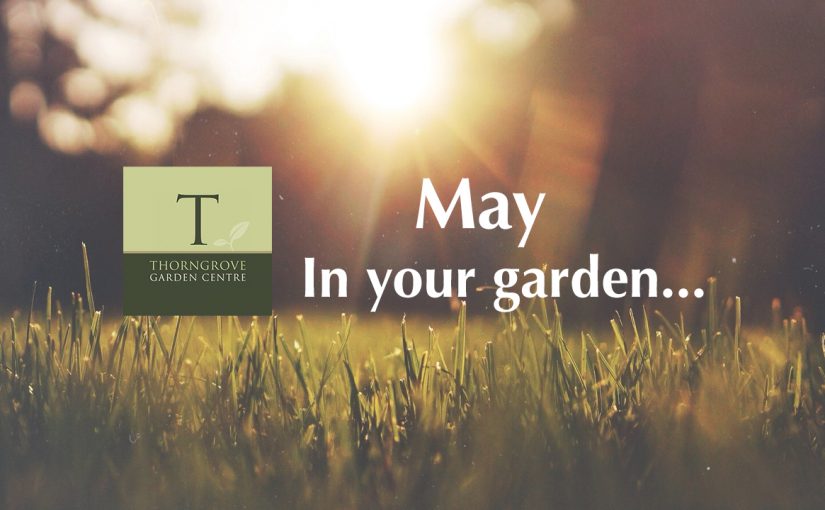
May is probably one of the busiest months of the year in the gardens, and here at Thorngrove! So what’s there do do?
Planting of pots and hanging baskets means lots of trips to your local garden centre to pick up all of your summer bedding plants and basket plants to make your garden look beautiful! If this is something you’re doing, and it’s possible keep them inside, do so and let them establish before putting them outside as there is still a risk of frost (this past April has been unusually cold!). By keeping them inside until they have rooted out will also increase their drought tolerance.
Plant your broad, dwarf and French beans either directly into the ground, or in to pots in the greenhouse, or even in the kitchen or conservatory window. This will keep them safe until final frosts have past which should be very soon.
Now the weather is warming up make sure you water more! Especially things like tomatoes, courgettes and cucumbers, as they like to be damp but not water logged. Also make sure to keep your hanging baskets and pots watered. Mulch your beds and borders as this will help with watering as it helps keeps moisture in about 2-3 inches deep. Optimise your watering regime – water early in the morning or late at night to get the most out of your water. You can start collecting and recycling water whenever you can.
Ponds
Remove duckweed and Blanket weed from ponds.
Thin out submerged oxygenators as they will soon take over the pond lay on the side of the pond to allow any insects , snails and other pond life to escape back into the water
Pests
May is possibly the worst month for pests so keep a weather eye open as greenfly, blackfly and whitefly will be multiplying very quickly with warm weather. Spray with a systemic bug killer to help keep them under control. Blackfly can sometimes be controlled by using a soapy spray.
Lawns
Apply nitrogen rich summer feed to your lawn to encourage leafy growth. Always fertilise after mowing to avoid disturbing the fertiliser on the surface. Always read the instructions on the box!
Those lawns are really going to start coming to life, so apply lawn weedkiller to your lawn now.
Water the grass during hot weather- particularly important for newly seeded or turfed . Don’t mow newly seeded grass until it is 3 inches high, and set mower blades on high setting.
Lower mower blades to their regular summer cutting height.
Look after your finished spring bulbs for next year. Resist the temptation of cutting them back but leave them to die down naturally as this will help feed the bulb for next year and give you a better display. Also water the clumps with a liquid fertiliser.
If you have a Greenhouse remember to open the vents and door on hot days. You could dampen down the path or floor to increase humidity and this also helps prevent that horrible pest Red Spider.
Harden of Half Hardy plants by putting them out during the day and bringing back undercover at night do this for 7-10 days before planting outside. It’s basically fitness training for your plants and can work wonders!
Continue dividing herbaceous perennials.
Divide your Hostas as they come into growth.
Lift Forget-me nots to prevent heavy self seeding and reduce spreading.
Trim back spreading plants such as Aubrieta, Alyssum, and Candy tuft after they have flowered to encourage fresh new growth and more blooms.
Continue with the weeding!
Vegetables
Continue earthing up potatoes.
If you grow Asparagus now is the time to harvest it.
Harden of outdoor tomatoes, courgettes. Squash and pumpkins.
Protect your carrots from carrotfly by covering with fleece.
Make supports for your runnerbeans using 2.4m (8ft) bamboo canes
Support pea plants using twiggy sticks or pea netting
Keep on top of the weeding as they will compete for water light and nutri.
Fruit
Harvest your Rhubarb
Protect Stawberries with straw (to control weeds and lift the fruits off the ground) cover with netting to keep the birds off.
If you’ve planted new fruit trees keep them well watered as they put on rapid growth also remove the blossom and fruits this will help them establish properly during their first year as you want them to put their roots down rather than fruiting so you end up with a good strong tree that will produce more fruit in the future.
If you need anything to help you with all this, please visit Throngrove and we can help. We’re more than happy to provide more free on the spot advice too.
Have a great month everyone!
Go Back
Created by Atomic Agency